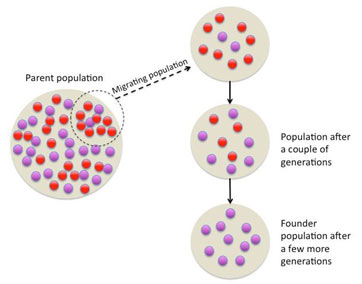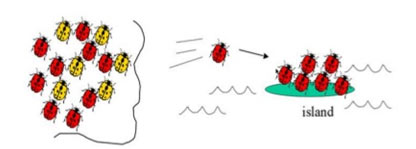Synopsis
Ernst Mayr, the Harvard evolutionist was the first person to propose the Founder effect in 1956. According to this, when a small group of population migrates from the main population on the limited gene pool is carried away with them.
In this type of small population, some genes may be absent or may be present in low frequency that they can easily be lost. So, these small populations are different from main populations and this is due to these colonizers or founders.
The founders or small population usually has unique genotypes and phenotypes which are not part of main population.
What is Founder Effect?
The Founder Effect the decrease in genetic variation that results when a little subset of a large population is utilized to develop a new colony. The new population may be very different from the original population, both in terms of its genotypes and phenotypes. In some cases, the founder effect contributes to the development of new species.
The founder effect is due to the randomness that accompanies selecting a small group from a larger population. The smaller sized the population, the greater the possibility that the small population does not represent the bigger population.
Why Founder Effect occur?
The founder effect can take place due to many different reasons and circumstances. The founder effect can be due to geographic isolation when a small population of individuals migrates to a new location. In this case, the distance or obstacles between the two populations make interbreeding difficult, and the new populations become genetically distinct gradually.
In another scenario, a mutation might trigger a population of organisms to become reproductively separated from the parents or ancestors’ structure. Without the capability to interbreed with the larger population, the small population ends up being unique. If effective it will grow into a new species. Mutations and random allele modifications in small populations are collectively called genetic drift, and the founder effect is a piece of genetic drift.

Low Genetic Variation
Populations that begin by doing this generally have actually limited genetic variation because they came from such a little pool of allele combinations. They normally have special genotypes and phenotypes not seen in the original population. This can likewise cause speciation due to the fact that this new group is separated from the original population.
Unless other organisms migrate to the location and mix, genetic mutation is the only method new alleles can enter the population. As a result, populations of founder species are especially sensitive to habitat and ecological modifications, and genetic diseases.
Examples of Founder Effect
Genetic Diseases in Human Beings
Afrikaner Dutch Population
We can see some interesting examples of this founder effect in human populations. A small number of colonists comprised the Afrikaner population of Dutch settlers. The descendants of these colonists have a really high level of the gene which triggers Huntington’s disease.
Although the basic Dutch population does not exhibit a high level of Huntington’s disease, the small group of initial inhabitants in South Africa most likely carried this gene at a higher frequency by random possibility. The founder effect can still be seen generations later on. It is a perfect example of how powerful genetic drift as a whole can be.
Small Islands
Ecologists have been studying small islands for a long period of time, as the populations in between small islands frequently show amazing variety. The Galapagos finches, for example, represent several species of finch that all look like a mainland finch, with numerous modifications. The theory remains that the population on the islands is under the influence of the founder effect.
The founder effect is a widely known cause of differentiation between populations that span a country mile. This is known as the serial founder effect if the specific populations spread over a geographical range do not interbreed.
Impacts of Founder Effect
Most founding events involve a reduction in population size, which in turn causes genetic drift effects that can diminish alleles. Besides minimizing neutral hereditary variability, the founder effect can in principle shift additive genetic variation for phenotypes that underlie fitness. This might then result in different rates of adaptation among populations that have actually undergone a population size bottleneck as well as an ecological modification, even when these populations have a common evolutionary history.
If a small sample of individuals is drawn from a larger population, there is a possibility that an allele will be lost. When it comes to 2 alleles, A and a, if the developing or emerging population are all aa homozygous then the A allele will be lost and the new population will be genetically monomorphic. In fact, the founding effect is rather inefficient at reducing genetic variation – even if the founding population is really small, even less than 10, it will usually possess both alleles.

